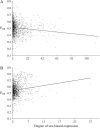Patterns of synonymous codon usage in Drosophila melanogaster genes with sex-biased expression
- PMID: 15937136
- PMCID: PMC1449783
- DOI: 10.1534/genetics.104.038109
Patterns of synonymous codon usage in Drosophila melanogaster genes with sex-biased expression
Abstract
The nonrandom use of synonymous codons (codon bias) is a well-established phenomenon in Drosophila. Recent reports suggest that levels of codon bias differ among genes that are differentially expressed between the sexes, with male-expressed genes showing less codon bias than female-expressed genes. To examine the relationship between sex-biased gene expression and level of codon bias on a genomic scale, we surveyed synonymous codon usage in 7276 D. melanogaster genes that were classified as male-, female-, or non-sex-biased in their expression in microarray experiments. We found that male-biased genes have significantly less codon bias than both female- and non-sex-biased genes. This pattern holds for both germline and somatically expressed genes. Furthermore, we find a significantly negative correlation between level of codon bias and degree of sex-biased expression for male-biased genes. In contrast, female-biased genes do not differ from non-sex-biased genes in their level of codon bias and show a significantly positive correlation between codon bias and degree of sex-biased expression. These observations cannot be explained by differences in chromosomal distribution, mutational processes, recombinational environment, gene length, or absolute expression level among genes of the different expression classes. We propose that the observed codon bias differences result from differences in selection at synonymous and/or linked nonsynonymous sites between genes with male- and female-biased expression.
Figures

Similar articles
-
Molecular evolution of sex-biased genes in Drosophila.Mol Biol Evol. 2004 Nov;21(11):2130-9. doi: 10.1093/molbev/msh223. Epub 2004 Jul 28. Mol Biol Evol. 2004. PMID: 15282334
-
Codon usage bias is correlated with gene expression levels in the fission yeast Schizosaccharomyces pombe.Genes Cells. 2009 Apr;14(4):499-509. doi: 10.1111/j.1365-2443.2009.01284.x. Genes Cells. 2009. PMID: 19335619
-
Variation in synonymous codon use and DNA polymorphism within the Drosophila genome.J Evol Biol. 2006 Jan;19(1):1-11. doi: 10.1111/j.1420-9101.2005.00996.x. J Evol Biol. 2006. PMID: 16405571
-
The evolution of sex-biased genes and sex-biased gene expression.Nat Rev Genet. 2007 Sep;8(9):689-98. doi: 10.1038/nrg2167. Epub 2007 Aug 7. Nat Rev Genet. 2007. PMID: 17680007 Review.
-
Mutation pressure, natural selection, and the evolution of base composition in Drosophila.Genetica. 1998;102-103(1-6):49-60. Genetica. 1998. PMID: 9720271 Review.
Cited by
-
Codon usage affects the structure and function of the Drosophila circadian clock protein PERIOD.Genes Dev. 2016 Aug 1;30(15):1761-75. doi: 10.1101/gad.281030.116. Genes Dev. 2016. PMID: 27542830 Free PMC article.
-
Rate of amino acid substitution is influenced by the degree and conservation of male-biased transcription over 50 myr of Drosophila evolution.Genome Biol Evol. 2012;4(3):346-59. doi: 10.1093/gbe/evs012. Epub 2012 Feb 8. Genome Biol Evol. 2012. PMID: 22321769 Free PMC article.
-
Similar levels of X-linked and autosomal nucleotide variation in African and non-African populations of Drosophila melanogaster.BMC Evol Biol. 2007 Oct 25;7:202. doi: 10.1186/1471-2148-7-202. BMC Evol Biol. 2007. PMID: 17961244 Free PMC article.
-
The unique genomic properties of sex-biased genes: insights from avian microarray data.BMC Genomics. 2008 Mar 31;9:148. doi: 10.1186/1471-2164-9-148. BMC Genomics. 2008. PMID: 18377635 Free PMC article.
-
Gender-specific selection on codon usage in plant genomes.BMC Genomics. 2007 Jun 13;8:169. doi: 10.1186/1471-2164-8-169. BMC Genomics. 2007. PMID: 17567911 Free PMC article.
References
Publication types
MeSH terms
Substances
LinkOut - more resources
Full Text Sources
Molecular Biology Databases

